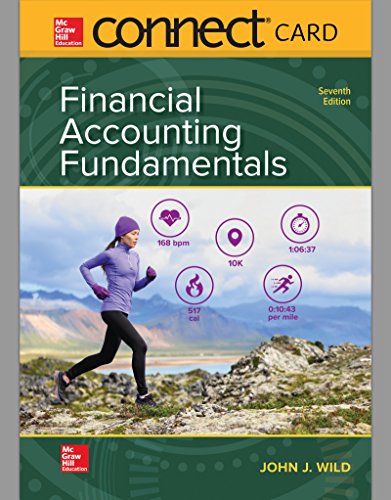
Connect Access Card For Financial Accounting Fundamentals
7th Edition
ISBN: 9781260482829
Author: John J Wild
Publisher: McGraw-Hill Education
expand_more
expand_more
format_list_bulleted
Question
Chapter 8, Problem 1MCQ
To determine
Ascertain the allocation of property costs to the three assets purchased.
Expert Solution & Answer
Explanation of Solution
Lump-Sum purchase:
If a company purchases a group of assets collectively and a lump sum amount is paid for such purchase, then it is referred to as basket purchase. The accounting term for this type of acquisition is the lump-sum purchase.
Ascertain the allocation of property costs to the three assets purchased as follows:
| Assets | Fair Market Value (in $) | Percent of total= | Allocation of the purchase price based on the percentage of total |
| Land | 175,000 | 163,000 | |
| Land Improvements | 70,000 | 65,200 | |
| Building | 105,000 | 97,800 | |
| Total | $350,000 | $326,000 |
Table (1)
Hence, the allocation of property costs to the three assets purchased is option b. Land, $163,000; Land Improvements, $65,200; Building, 97,800.
Want to see more full solutions like this?
Subscribe now to access step-by-step solutions to millions of textbook problems written by subject matter experts!
Students have asked these similar questions
I am looking for help with this general accounting question using proper accounting standards.
Can you help me solve this general accounting problem with the correct methodology?
Can you help me solve this general accounting problem using the correct accounting process?
Chapter 8 Solutions
Connect Access Card For Financial Accounting Fundamentals
Ch. 8 - Prob. 1MCQCh. 8 - Prob. 2MCQCh. 8 - Prob. 3MCQCh. 8 - Prob. 4MCQCh. 8 - Prob. 5MCQCh. 8 - Prob. 1DQCh. 8 - Prob. 2DQCh. 8 - Prob. 3DQCh. 8 - Prob. 4DQCh. 8 - Prob. 5DQ
Ch. 8 - Prob. 6DQCh. 8 - Prob. 7DQCh. 8 - Prob. 8DQCh. 8 - Prob. 9DQCh. 8 - Prob. 10DQCh. 8 - Prob. 11DQCh. 8 - Prob. 12DQCh. 8 - Prob. 13DQCh. 8 - Prob. 14DQCh. 8 - Prob. 15DQCh. 8 - Prob. 16DQCh. 8 - Prob. 17DQCh. 8 - Prob. 18DQCh. 8 - Prob. 19DQCh. 8 - Prob. 20DQCh. 8 - Prob. 21DQCh. 8 - Prob. 1QSCh. 8 - Prob. 2QSCh. 8 - Prob. 3QSCh. 8 - Prob. 4QSCh. 8 - Prob. 5QSCh. 8 - Prob. 6QSCh. 8 - Prob. 7QSCh. 8 - Prob. 8QSCh. 8 - Prob. 9QSCh. 8 - Prob. 10QSCh. 8 - QS 8-11 Classifying assets
Identify the following...Ch. 8 - Prob. 12QSCh. 8 - Prob. 13QSCh. 8 - Prob. 14QSCh. 8 - Prob. 15QSCh. 8 - Prob. 1ECh. 8 - Prob. 2ECh. 8 - Prob. 3ECh. 8 - Prob. 4ECh. 8 - Prob. 5ECh. 8 - Prob. 6ECh. 8 - Exercise 8-7 Straight-line depreciation
In early...Ch. 8 - Exercise 8-8 Double-declining-balance...Ch. 8 - Prob. 9ECh. 8 - Exercise 8-10 Double-declining-balance...Ch. 8 - Prob. 11ECh. 8 - Prob. 12ECh. 8 - Prob. 13ECh. 8 - Prob. 14ECh. 8 - Prob. 15ECh. 8 - Prob. 16ECh. 8 - Prob. 17ECh. 8 - Prob. 18ECh. 8 - Prob. 19ECh. 8 - Prob. 20ECh. 8 - Prob. 21ECh. 8 - Prob. 22ECh. 8 - Prob. 23ECh. 8 - Prob. 24ECh. 8 - Prob. 25ECh. 8 - Prob. 1APCh. 8 - Prob. 2APCh. 8 - Prob. 3APCh. 8 - Prob. 4APCh. 8 - Prob. 5APCh. 8 - Prob. 6APCh. 8 - Prob. 7APCh. 8 - Prob. 8APCh. 8 - Prob. 1BPCh. 8 - Prob. 2BPCh. 8 - Prob. 3BPCh. 8 - Prob. 4BPCh. 8 - Prob. 5BPCh. 8 - Prob. 6BPCh. 8 - Prob. 7BPCh. 8 - Prob. 8BPCh. 8 - Prob. 8SPCh. 8 - Prob. 1BTNCh. 8 - Prob. 2BTNCh. 8 - Prob. 3BTNCh. 8 - Prob. 7BTNCh. 8 - Prob. 9BTN
Knowledge Booster
Similar questions
- Solve with explanation and accounting questionarrow_forwardIf $34,500 was generated from operations, $22,800 was used for investing activities, and $5,300 was provided by financing activities, the cash balance would: A. increase by $23,000. B. increase by $17,000. C. increase by $10,000. D. decrease by $20,000.arrow_forwardGet correct answer with accounting questionarrow_forward
arrow_back_ios
SEE MORE QUESTIONS
arrow_forward_ios
Recommended textbooks for you

 AccountingAccountingISBN:9781337272094Author:WARREN, Carl S., Reeve, James M., Duchac, Jonathan E.Publisher:Cengage Learning,
AccountingAccountingISBN:9781337272094Author:WARREN, Carl S., Reeve, James M., Duchac, Jonathan E.Publisher:Cengage Learning, Accounting Information SystemsAccountingISBN:9781337619202Author:Hall, James A.Publisher:Cengage Learning,
Accounting Information SystemsAccountingISBN:9781337619202Author:Hall, James A.Publisher:Cengage Learning, Horngren's Cost Accounting: A Managerial Emphasis...AccountingISBN:9780134475585Author:Srikant M. Datar, Madhav V. RajanPublisher:PEARSON
Horngren's Cost Accounting: A Managerial Emphasis...AccountingISBN:9780134475585Author:Srikant M. Datar, Madhav V. RajanPublisher:PEARSON Intermediate AccountingAccountingISBN:9781259722660Author:J. David Spiceland, Mark W. Nelson, Wayne M ThomasPublisher:McGraw-Hill Education
Intermediate AccountingAccountingISBN:9781259722660Author:J. David Spiceland, Mark W. Nelson, Wayne M ThomasPublisher:McGraw-Hill Education Financial and Managerial AccountingAccountingISBN:9781259726705Author:John J Wild, Ken W. Shaw, Barbara Chiappetta Fundamental Accounting PrinciplesPublisher:McGraw-Hill Education
Financial and Managerial AccountingAccountingISBN:9781259726705Author:John J Wild, Ken W. Shaw, Barbara Chiappetta Fundamental Accounting PrinciplesPublisher:McGraw-Hill Education


Accounting
Accounting
ISBN:9781337272094
Author:WARREN, Carl S., Reeve, James M., Duchac, Jonathan E.
Publisher:Cengage Learning,

Accounting Information Systems
Accounting
ISBN:9781337619202
Author:Hall, James A.
Publisher:Cengage Learning,

Horngren's Cost Accounting: A Managerial Emphasis...
Accounting
ISBN:9780134475585
Author:Srikant M. Datar, Madhav V. Rajan
Publisher:PEARSON

Intermediate Accounting
Accounting
ISBN:9781259722660
Author:J. David Spiceland, Mark W. Nelson, Wayne M Thomas
Publisher:McGraw-Hill Education

Financial and Managerial Accounting
Accounting
ISBN:9781259726705
Author:John J Wild, Ken W. Shaw, Barbara Chiappetta Fundamental Accounting Principles
Publisher:McGraw-Hill Education